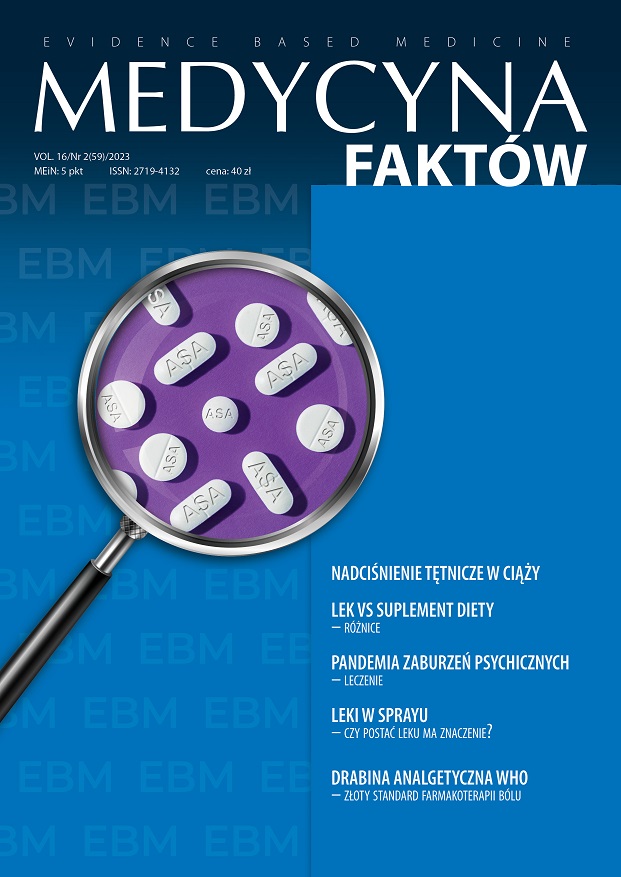When is it worth using acemetacin – internist’s point of view? Review article
Main Article Content
Abstract
Non-steroidal anti-inflammatory drugs are commonly used to alleviate pain and inflammation in various conditions. The frequency and severity of pain increase with age, making older individuals more dependent on analgesic treatment. The aim of this summary is to present the efficacy and safety profile of acemetacin compared to other nonsteroidal anti-inflammatory drug.
Acemetacin stands out with a good safety profile and efficacy in relieving pain and inflammation. In addition to inhibiting COX-1 and COX-2, acemetacin also affects other inflammatory mediators such as histamine and bradykinin. Studies have shown that acemetacin demonstrates similar anti-inflammatory efficacy to indomethacin but with a lower incidence of gastrointestinal and other adverse effects. Comparisons with diclofenac have also revealed comparable anti-inflammatory and analgesic effects. The therapeutic efficacy of acemetacin has been observed at doses of 60 mg 3 times daily, which is equivalent to 50 mg of diclofenac, with a significantly lower risk of gastrointestinal adverse effects.
Furthermore, the balanced elimination of acemetacin, with 60% excreted through the liver and a smaller portion through the kidneys, contributes to its improved safety profile. It is important to consider patient factors such as alcohol consumption, obesity, age, and comorbidities when determining the dosage and selecting the appropriate nonsteroidal anti-inflammatory drug. The pharmacokinetic properties of nonsteroidal anti-inflammatory drugs, such as solubility in fat or water, should also be taken into account in patients with specific body composition or dehydration states. Acemetacin as a nonsteroidal anti-inflammatory drug is a therapeutic option worth considering.
Article Details
Copyright © by Medical Education. All rights reserved.
References
2. Ribeiro H, Rodrigues I, Napoleão L et al. Non-steroidal anti-inflammatory drugs (NSAIDs), pain and aging: Adjusting prescription to patient features. Biomed Pharmacother. 2022; 150: 112958. http://doi.org/10.1016/j.biopha.2022.112958.
3. Chávez-Piña AE, McKnight W, Dicay M et al. Mechanisms underlying the anti-inflammatory activity and gastric safety of acemetacin. Br J Pharmacol. 2007; 152(6): 930-8. http://doi.org/10.1038/sj.bjp.0707451.
4. Bacchi S, Palumbo P, Sponta A et al. Clinical pharmacology of non-steroidal anti-inflammatory drugs: a review. Antiinflamm Antiallergy Agents Med Chem. 2012; 11(1): 52-64. http://doi.org/10.2174/187152312803476255.
5. Państwowa Agencja Rozwiązywania Problemów Alkoholowych. Spożycie w litrach na jednego mieszkańca (access: 19.07.2023).
6. Bindu S, Mazumder S, Bandyopadhyay U. Non-steroidal anti-inflammatory drugs (NSAIDs) and organ damage: A current perspective. Biochem Pharmacol. 2020; 180: 114147. http://doi.org/10.1016/j.bcp.2020.114147.
7. Wełnicki M. Bezpieczeństwo i skuteczność stosowania niesteroidowych leków przeciwzapalnych – acemetacyna okiem internisty. Medycyna Faktów. 2017; 2(35): 124-8.
8. Müller P, Dammann HG, Langer M et al. Ranitidin vermindert die durch Acemetacin und Indometacin induzierten gastroduodenalen Schleimhautveränderungen, ohne das pharmakokinetische Verhalten beider Antirheumatika zu beeinflussen [Ranitidine ameliorates acemetacin and indomethacin-induced changes of the gastroduodenal mucosa, without modifying the pharmacokinetic behavior of both antirheumatic drugs]. Z Gastroenterol. 1989; 27(2): 83-6.
9. Pelletier JP, Martel-Pelletier J, Rannou F et al. Efficacy and safety of oral NSAIDs and analgesics in the management of osteoarthritis: Evidence from real-life setting trials and surveys. Semin Arthritis Rheum. 2016; 45(4 suppl): S22-7. http://doi.org/10.1016/j.semarthrit.2015.11.009.
10. Kocot-Kępska M, Kierzkiewicz M, Białoszewski D. Czy warto stosować acemetacynę? Spojrzenie wielodyscyplinarne. Medycyna Faktów. 2018; 1(38): 59-62.

